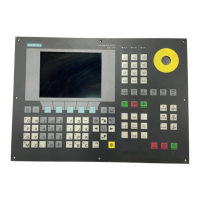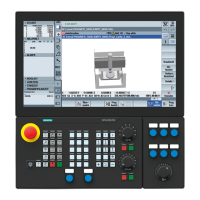Transformations
6.2 Three, four and five axis transformation (TRAORI)
Job planning
Programming Manual, 07/2010, 6FC5398-2BP40-0BA0
323
Examples
1. Example of machine kinematics CA (channel axis names C, A)
ORIRESET(90, 45) ;C at 90 degrees, A at 45 degrees
ORIRESET(, 30) ;C at $MC_TRAFO5_ROT_AX_OFFSET_1/2[0], A at 30 degrees
ORIRESET( ) ;C at $MC_TRAFO5_ROT_AX_OFFSET_1/2[0],
;A at $MC_TRAFO5_ROT_AX_OFFSET_1/2[1]
2. Example of machine kinematics CAC (channel axis names C, A, B)
ORIRESET(90, 45, 90) ;C at 90 degrees, A at 45 degrees, B at 90 degrees
ORIRESET( ) ;C at $MC_TRAFO5_ROT_AX_OFFSET_1/2[0],
;A at $MC_TRAFO5_ROT_AX_OFFSET_1/2[1],
;B at $MC_TRAFO5_ROT_AX_OFFSET_1/2[2]
Programming LEAD, TILT and THETA rotations
In respect of three- to five-axis transformation, tool orientation rotations are programmed with
the LEAD and TILT angles.
In respect of a transformation with third rotary axis, additional programming settings for C2
(rotations of the orientation vector) are permitted for both orientation with vector components
and with entry of the LEAD, TILT angles.
With an additional third rotary axis, the rotation of the tool about itself can be programmed
with the THETA rotary angle.
6.2.4 Programming of the tool orientation (A..., B..., C..., LEAD, TILT)
Function
The following options are available when programming tool orientation:
1. Direct programming the motion of rotary axes. The change of orientation always occurs in
the basic or machine coordinate system. The orientation axes are traversed as
synchronized axes.
2. Programming in Euler or RPY angles in accordance with angle definition using
A2, B2,
C2
3. Programming of the direction vector using
A3, B3, C3 The direction vector points from the
tool tip toward the tool adapter.
4. Programming the surface normal vector at the start of the block with
A4, B4, C4 and at
the end of the block with
A5, B5, C5 (face milling).
5. Programming using lead angle
LEAD and tilt angle TILT
6. Programming of rotary axis of taper as normalized vector using
A6, B6, C6 or of
intermediate orientation on the peripheral surface of a taper using
A7, B7, C7,
see "Orientation programming along the peripheral surface of a taper (ORIPLANE,
ORICONxx)".
7. Programming of reorientation, direction and path length of tool during retraction
movement using
A8, B8, C8,
see "Smoothing the orientation characteristic (ORIPATHS A8=, B8=, C8=)"

